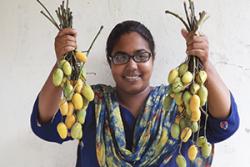Have Bangor University researchers helped to solve the chocolate crisis?
 Chocoholics around the globe have been aware for the last few years that their favourite sweet treat is under threat. Researchers at Bangor University may have come up with an answer that could help find a solution to the chocolate crisis by using wild mango as a new cocoa butter alternative.
Chocoholics around the globe have been aware for the last few years that their favourite sweet treat is under threat. Researchers at Bangor University may have come up with an answer that could help find a solution to the chocolate crisis by using wild mango as a new cocoa butter alternative.
Global production of cocoa is in decline due to a combination of factors including crop failure, disease and ageing plantations, leading to price fluctuations and a shortfall in supply. Cocoa butter is the pure butter extracted from cocoa beans and is one of the unique natural fats highly demanded by food, pharmaceuticals and cosmetic industries and in particular is a major ingredient in the chocolate industry. Cocoa butter is currently the only commercially available natural fat which is rich in saturated and monounsaturated fatty acids. Moreover, the price of cocoa butter is one of the highest among all tropical fats and oils and according to International Cocoa Organisation (2015), the price of cocoa butter more than doubled between 2005 and 2015. All of which has presented a pressing need to the chocolate industry to find high quality alternatives as the demand for cocoa is predicted to rise by 30% by 2020.
A recent study published in Scientific Reports explored the potential of a wild mango (Mangifera sylvatica Roxb.), an underutilised fruit species of south east Asia, to provide an alternative source of butter for the industry. Analyses showed that wild mango butter has a very similar chemical, physical and thermal profile to cocoa butter. However, wild mango butter has several superior properties to cocoa butter. It has a higher solid triglyceride (SOS) content which is used for improving soft cocoa butters, which indicates it has the potential to become a cocoa butter improver. Wild mango butter has a higher moisture content than cocoa butter, and there is a growing body of evidence that higher moisture content butters produce low fat chocolate, which may help to prevent obesity, heart diseases, diabetics, stroke and arthritis. Wild mango has the added advantage of being a fruit with a large kernel (40-50% of its body mass) and therefore a proportionality higher fat content (9-14%) than the smaller kernelled domesticated mango.
 Senior author Sayma Akhter with wild mango fruit.Sayma Akhter, the senior author and a postgraduate student at the School of Environment, Natural Resources & Geography, said: “Wild mango is one of the so-called ‘Cinderella’ species whose real potential is unrealised. The identification of real added value as we have shown in this study, could pluck it from obscurity into mainstream production. With the support of government and non-governmental organisations, small scale industries could be set up to create a new income source for local people. There are many other new products that can come from underutilised fruits which are still waiting for proper attention.”
Senior author Sayma Akhter with wild mango fruit.Sayma Akhter, the senior author and a postgraduate student at the School of Environment, Natural Resources & Geography, said: “Wild mango is one of the so-called ‘Cinderella’ species whose real potential is unrealised. The identification of real added value as we have shown in this study, could pluck it from obscurity into mainstream production. With the support of government and non-governmental organisations, small scale industries could be set up to create a new income source for local people. There are many other new products that can come from underutilised fruits which are still waiting for proper attention.”
Professor Morag McDonald, Head of the School of Environment, Natural Resources & Geography, and one of the report’s authors added: “Going beyond the use to industry, wild fruits like the mango are an important source of food, medicine and income for rural dwellers, but are in decline due to drivers such as deforestation. Adding value to underutilised products through processing for products that have market value can generate a valuable incentive for the conservation of such species, and help to generate alternative income sources and reduce household poverty”.
This research was funded through the European Union’s FONASO (Forest and Nature for Society) Erasmus Mundus Joint Doctoral Programme.
Publication date: 1 September 2016
